
|   |

|   |
Reconstructing a lost legacy: Kaisiki Natakam 2015 - Veejay Sai e-mail: kyaabaathain@gmail.com December 24, 2015 For the last many years, dancer Anita Ratnam would mention in passing about Kaisiki Natakam, but I never took it seriously. My initial thoughts were it was a local temple festival. I even asked a friend who said it was an ‘Iyengar affair.’ This year, my curiosity got the better of me and I was on the next flight to Tamil Nadu. It was one of the best journeys I took! Thirukurungudi isn’t the easiest place to reach. A flight from Delhi to Chennai, another from Chennai to Tuticorin and a road journey of eighty kilometers into the wilderness of Thirunelveli district. On my flight from Chennai to Tuticorin, my neighbour was a young politician Sasikala Prabha, a Member of Parliament and the head of the women’s wing for AIADMK. We got into a conversation and she told me about the local history of Thoothukudi (Tuticorin). That it was a ‘Pearl city’ and how it was an arid land once and water was brought in from Ceylon. How the salt trade flourished and the stories of local heroes like V.O. Chidambaram Pillai who launched the first ship trade between Ceylon and Tuticorin. I asked her if she had heard about this festival I was headed to and she replied with a vague yes, before continuing to tell me about the famous Thoothukudi macaroons and how different they were with the taste of cashew nuts. After we landed in Tuticorin, we parted ways with me assuring her that I wouldn’t miss those macaroons. A road journey for eighty kilometers into the Thirunelveli district and I was in the temple town of Thirukurungudi by teatime. I checked into the two hundred and fifty year old ancestral bungalow of the great TVS Iyengar in one of the lanes beside the temple. The high walls of the temple painted with white and red stripes the old fashioned way, were facing my cottage. Keeping the original aesthetic of the place, and refurbishing the inside with modern amenities, this was a heaven to stay in. Hot golden Medu Vadais and a tumbler of filter Kaapi made by Balaji, the expert cook, welcomed me. In the next forty-eight hours in Thirukurungudi, Balaji was responsible for me to put on undiluted Iyengar calories with his cooking. I met Mr. Veerasundaram, a former public relations officer with the TVS group. He was to be my local guide for the trip. My first trip to the temple was the same evening. I met Shri Thirunarayana Iyengar, an octogenarian scholar of Sanskrit, Tamil literature and history. I was joined by Gerard M Samuel, a professor of dance at the Cape Town University in South Africa. Later that night, Gerard and I sat into a long conversation about dance history. He told me about his ancestors being of Masilamani origin. Gerard himself was the first African citizen of Indian origin to make international news in ballet. A day and a night with Nambi Next morning, my cottage was decorated with beautiful kolams outside. Joining us for sumptuous breakfast were dancers Roja Kannan, Priya Murle, Srikanth Natarajan and his wife Aswathy. After breakfast, we did rounds of the temple. The eighteen-acre complex is scattered with little temples. The main vimaanam leads to the Nambi temple. The history and architectural detail of the temple has already been written about here Shri Thirunarayana Iyengar, the octogenarian local expert toured me around the place. Evening in a makeshift stage in one of the corridors, the inaugural performances were arranged. With excellent nadaswaram by S.K. Veliammal and Shankarammal, the evening began. It was impressive to see two women handle this instrument which requires great breath control and a powerful stamina. Anita mentioned to me how the TVS family patronized their mother and the instruments they were performing on were gifted to them. Accompanying them on the thavil was Nagarcoil Selvam. Slide show Photos: Veejay Sai 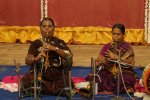

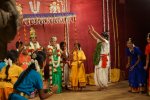
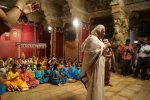
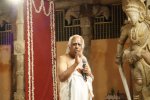 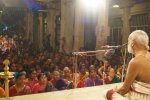
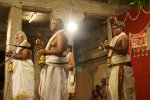
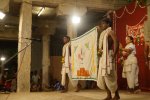

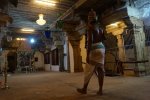
After their performance, the dance-quartet of Roja Kannan, Priya Murle, Srikanth Natarajan and Aswathy presented a dance presentation of Subramania Bharatiyar’s poems. Once again, very jana ranjakam in nature, the performance had some of the famous Bharatiyar songs. One could see the audience excitedly humming along. After that, Prof S. Ramanujam introduced his next production. The story of Andal was performed by a group of village children. It only took me the entire play to know what a genius of a director and a theatre personality Ramanujam was. All these children were trained by him over a period of time and tuned into excellent actors. Within the production, we saw how he used different kinds of scenography for various plots within the story. Using simple but elegant props to suit the purpose, it was impressive to see how Prof. Ramanujam took great care of details. Every student who participated in the play knew the entire script, lyrics and songs by heart. They were all humming and singing along. After the play I had chance to have a brief conversation with the professor. He told me how he was a graduate of the National School of Drama. He was a student of Ebrahim Alkazi and studied at NSD between 1963 and 1967. He mentioned some of his famous classmates and juniors and also spoke of his guru Alkazi with great reverence. Prof. Ramanujam also helped reconstruct the Kaisiki Natakam. I promised to visit him in Thanjavur sometime and do a detailed interview with him and his life at NSD. That will remain unfulfilled as he made a sudden exit from this world only two weeks later. Prof. Ramanujam succumbed to a massive heart attack on December 7. With his death, India lost an excellent theatre professional, a caring guide and a link to the past. After this, we headed to the main mandapam where the Kaisiki Natakam was conducted. Before the show, Thirunarayana Iyengar gave a brief lecture to a packed hall on its history and importance. That night, there could have easily been over five thousand people, eagerly looking forward to the performance. Being a traditional night of Ekadashi, where everyone has to be awake observing a Jagaranam, everyone sat up with much devotion. The play was conducted, once again, by Prof. Ramanujam with the help of Guru Herambanathan and his son Hari. What was interesting was the usage of various theatrical techniques and meters to reconstruct this. The play began with the traditional Purva Ranga of Sanskrit theatre. Each character was introduced as the play progressed. The story of Nambaduvan unfolded gradually. The tale of a Brahmin devotee, who has to redeem himself from a curse by taking help from a non-Brahmin was yet another wonderful twist to the story. One could do a whole socio-anthropological study of the play. What was amazing was how it was all carefully stitched together. It must have been a massive task for scholars like Prof. Ramanujam to bring about this seamlessness with their theatre. At times when you felt the text was weak, the performances outshone, and at other times, the story took you along. When the actual temple Rakshasa comes to bless the play and the actor playing his role was a touching moment in the play. Suddenly the audiences woke up and were brought back into the story. At one point while describing the Dasavatarams, when there was a shortage of dancers, Roja Kannan and Priya Murle pitched in with their own talent. This amazing quality of flexibility in adaptation, and yet adhering to the traditional narrative was one of the magic of reconstructing the play. Hundreds of devout rasikas stayed up all night and enjoyed the performance into the wee hours of the morning. The performance ended with the entire cast paying their tributes to the Utsava Murty, who was placed across the other end of the hall, and who was the actual audience the play was being performed for. Like in a Koothambalam, the performer keeps the fire lamp as a constant companion, god and audience, here the Utsava Murty was receiving the same honours. After the play, around four in the morning was offered the Arayer Sevai in the presence of the Jeer of the Mutt. Thirukurungudi is where the Arayer Sevai originated. This time the Sevai was very brief with the Arayer reading only two of the Pasurams. By sunrise, we left Thirukurungudi, taking memories of Azhagiya Nambi and the wonderful Kaisiki Natakam with us. Everyone who loves history, art, anthropology and performing traditions must make a visit at least once in their life to this temple town. Veejay Sai is a writer, editor and a culture critic. |